The Impact of the November 2023 Core Update
On November 2, 2023, Google released its third core update in four months. Surprisingly, the update took nearly a month to roll out with Google announcing its completion on November 28th which is a divergence from the usual two or so weeks it takes for an update to complete.
Today we released the November 2023 core update. We'll update our ranking release history page when the rollout is complete: https://t.co/hgjEkfpbA2
— Google Search Central (@googlesearchc) November 2, 2023
Related to this, we’ve posted a Q&A on Google Search updates as a refresher about how updates work: https://t.co/N5p3KsJ0ta
However, it was not just the length of the rollout that made the November 2023 Core Update “peculiar”. Let’s see why.
The Intersection of The November 2023 Core And Reviews Update
Analyzing the November 2023 Core Update is made incredibly complicated by the fact that Google rolled out the November 2023 Review Update just six days later. This update was also quite prolonged as it was not completed until December 7th.
the November 2023 reviews update is also rolling out now (as per my last email: https://t.co/xny94FOVvn)
— Google Search Central (@googlesearchc) November 8, 2023
we'll update the ranking release history page when the rollout is finished: https://t.co/hgjEkfpbA2
The obvious complication is how to parse out rank volatility and ascribe it to a specific update. Simply, if you saw ranking movement after November 6th how are you to know if the core or reviews update is responsible?
Moreover, how can we analyze the November 2023 Core Update in aggregate due to the data overlap that clearly exists?
Before I try to tackle answering both of these questions I just want to point out the absolute anomaly that we’re dealing with. Not only have we had 6 official Google updates since August (including a Link Spam and Helpful Content Update) but the roll-out of both November updates is more than a bit odd as I mentioned earlier.
While I could speculate as to the reasons behind some of the odd volatility we’ve seen over the past few months, I won’t do that here. All I will say is that “something” is going on and is quite peculiar.
The Ranking Impact of the November 2023 Core Update
To deal with the problem presented by the November 2023 Reviews Update (i.e., the overlap in volatility), this post will only be looking at rank fluctuations between November 2 and 7.
In this way, we don’t have any official overlap between the November 2023 Reviews Update and the November 2023 Core Update. This does mean that there is a bit of a limitation in analyzing the full scope of the November 2023 Core Update. However, I feel we do have enough isolated volatility to get a decent sense of the November 2023 Core Update regardless.
Looking at the rollout of the November 2023 Core Update, the initial spike in volatility came in rather quickly. As you can see, there are additional waves of volatility but as mentioned, it’s difficult to ascribe these spikes to the November 2023 Core Update as the Reviews Update was rolling out concurrently.
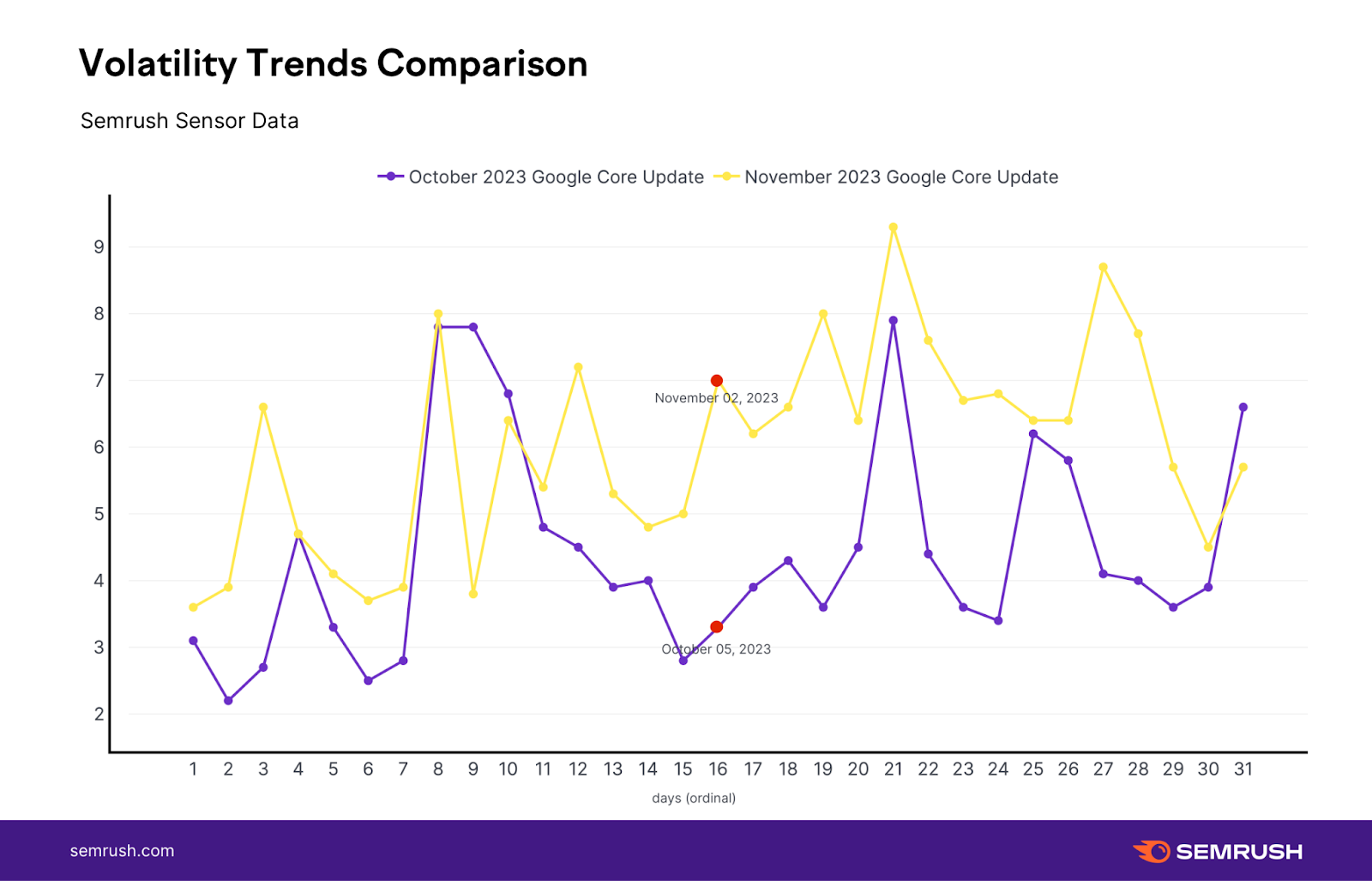
Comparing the October 2023 and November 2023 Core Updates
In comparing the October 2023 Core Update to the November 2023 Core Update the burst in rank volatility shows the November update to hit higher peak levels of volatility.
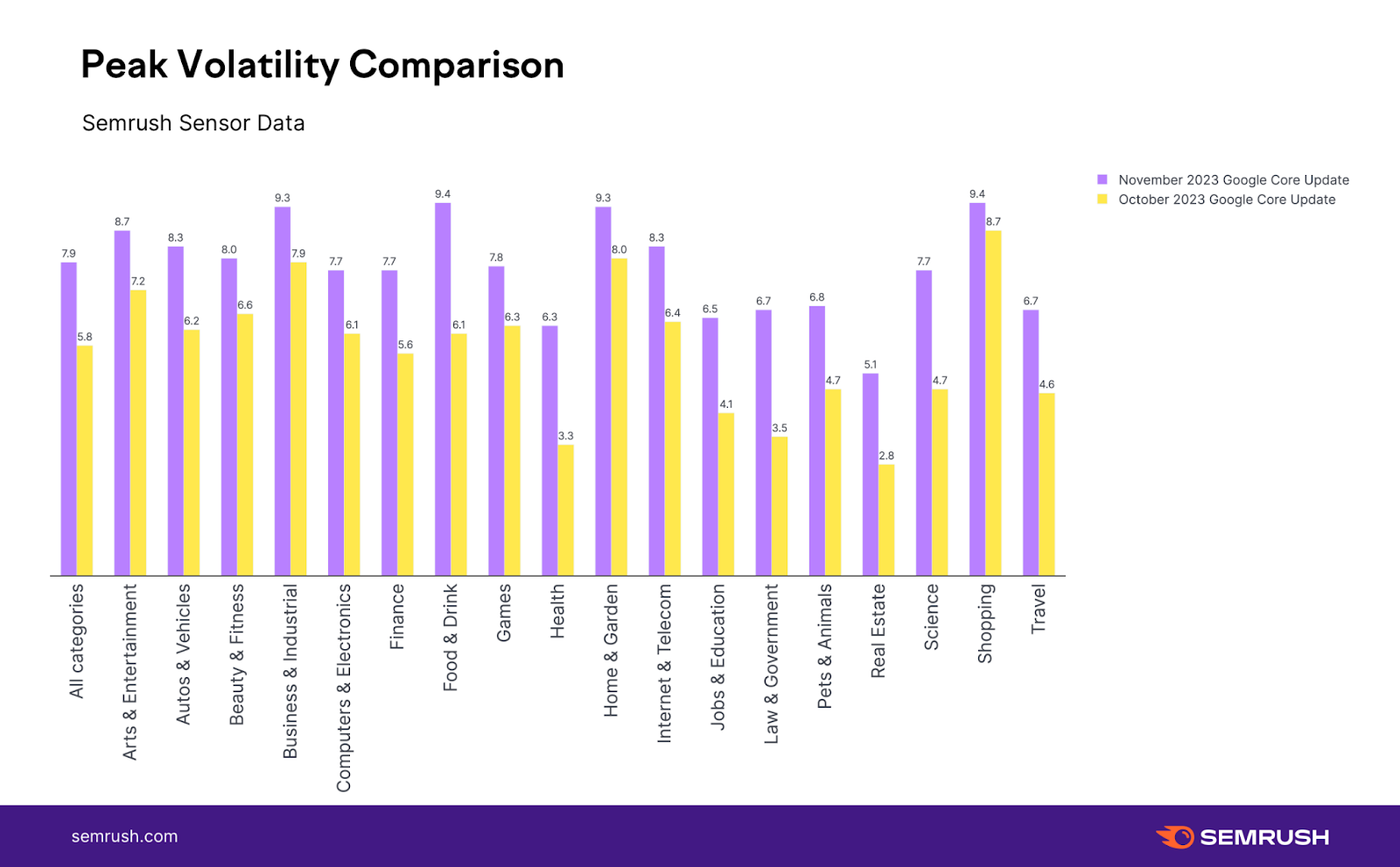
While this is often not my go-to metric for analyzing an update, it does come into stronger focus as both updates had a normative rollout and came in close proximity to each other. The latter point is significant as it means that the levels of overall volatility were most likely in the relative range of each other.
One thing to notice is the discrepancy between peak volatility within the Health niche - which outpaced the overall average and saw nearly a doubling in peak levels of volatility.
It’s a pattern that continued when further qualifying the impact of the November 2023 Core Update. As can be seen below, not only is the level of volatility relative to the baseline period higher in November but the Health vertical saw some of the most disproportionate increases.
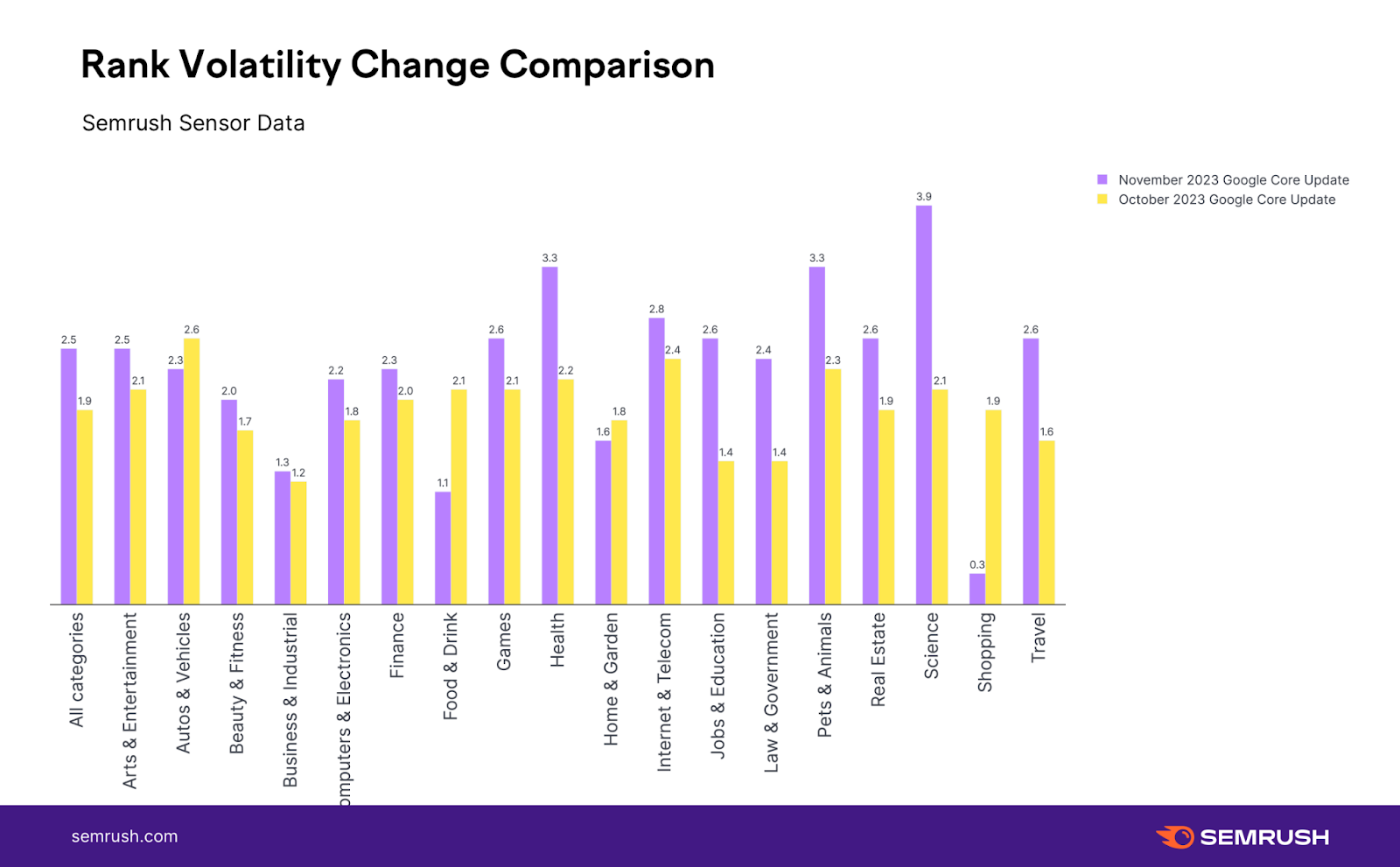
When analyzing a core update, seeing an increase in a Your Money Your Life (YMYL) centric niche like the Health Vertical is always something to note.
While the November 2023 Core Update seems to have displayed noticeably more volatility than the October 2023 Core Update the average level of that volatility seems to be within range of each other.
As seen below, the average number of positions lost during the November 2023 Core Update was 2.76. Back in October, the average number of positions lost was 2.62 - a marginal difference.
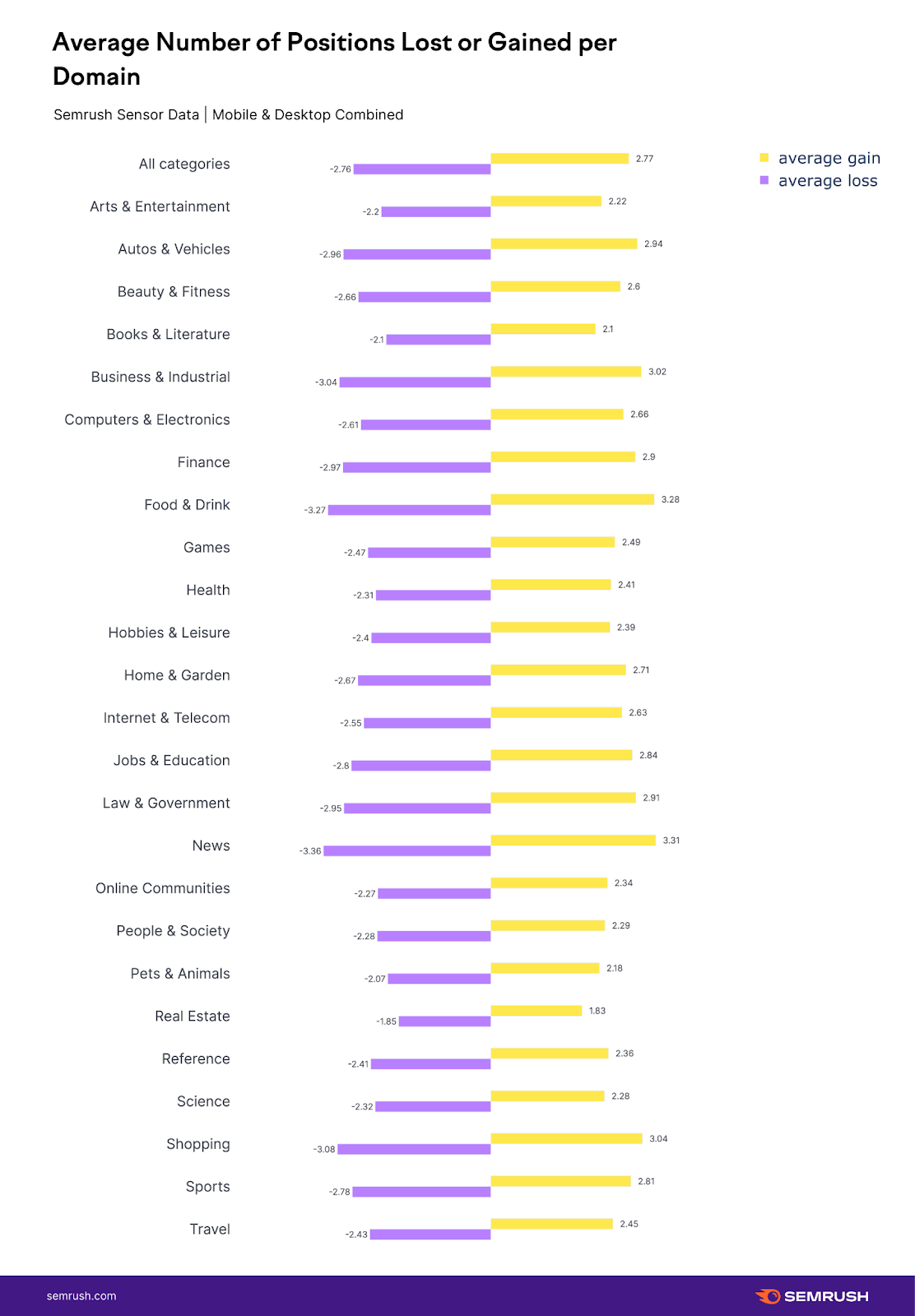
However, this does point to a limitation in using this metric alone to assess how drastic rank volatility was during a core update.
This as 25% of the URLs ranking in position 20 or better post-update were not even within the top 20 organic results prior to the November 2023 Core Update.
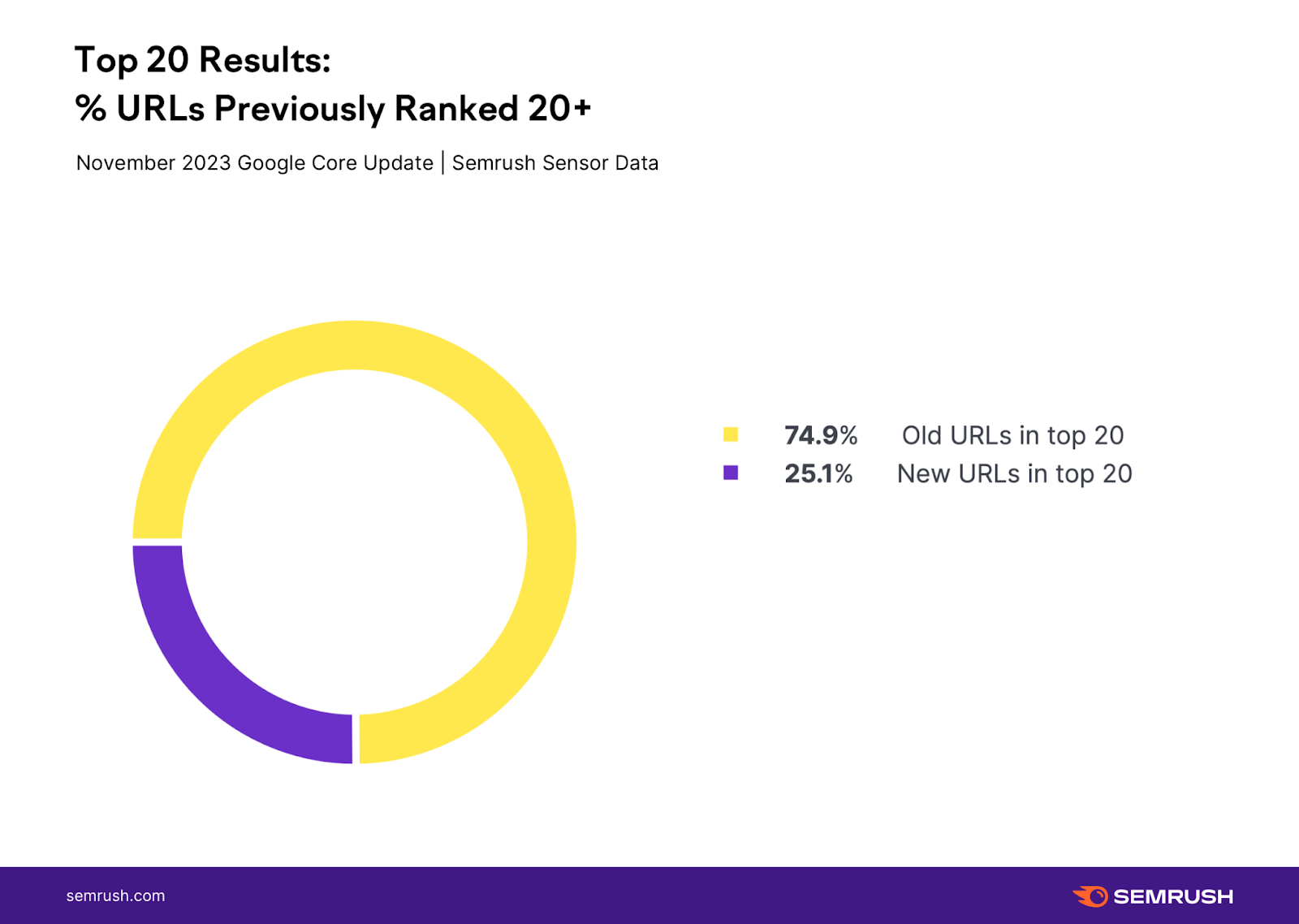
This stands in contrast to 22% of results ranking within the top 20 that did not rank within the initial 20 results prior to the October 2023 Core Update.
This trend continues when looking at the top 10 results. Again, there is a significant difference in the percentage of top 10 URLs that did not rank top 20 prior to the update in November.
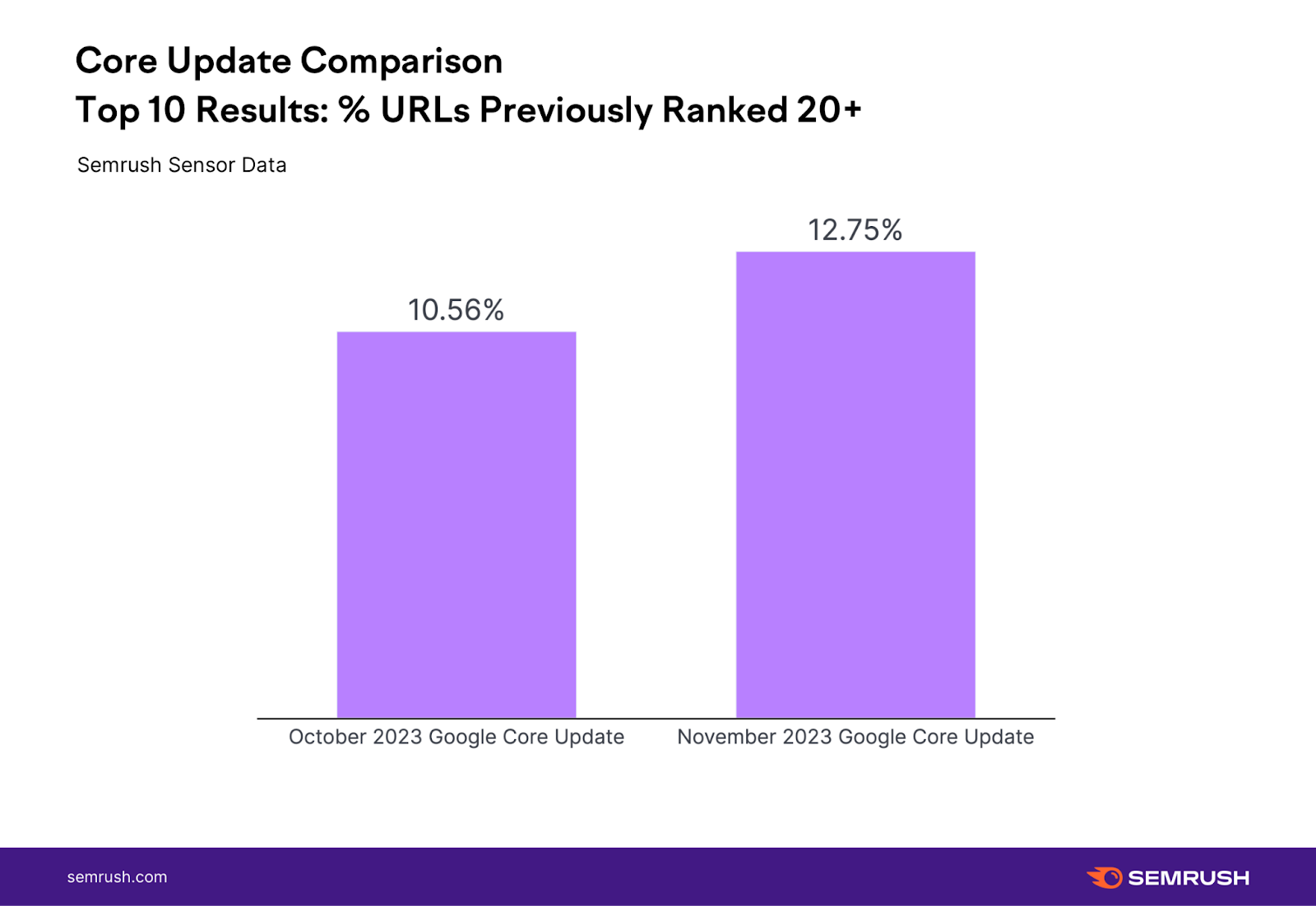
This points to a wider trend of some concern where the ranking movement during a core update seems to be increasingly more and more drastic over time. For context, back in September 2022, this number stood at 6.7% while in March of 2023, it jumped to 8.7%, and now with the latest core update, we’re at 12.75%.
There is a clear trend here.
How To Asses Rank Volatility In the Wake of the November 2023 Core Update
Now to the more complicated question: How do I know if the volatility I saw was from the November 2023 Core Update or the November 2023 Reviews Update?
Before I get into some possible ways to decipher the volatility I have to ask, does it really matter?
There is a lot of similarity in approach to both update types in my opinion with an emphasis on content quality being at the forefront of it. I see very little practical difference in the steps you would take to deal with a ranking loss in either case.
But assume for a second you want to know…
First, look at the type of keyword. If it’s a keyword that deals with some sort of commerce intent where review content appears - the Reviews Update is a logical place to start. That’s true even if your URL does not reflect review content per se. It’s certainly the overarching shifts on the SERP to review-centric content that have impacted your ranking on that same SERP.
Of course, core updates can impact commerce queries where review content ranks as well. In fact, both updates may have impacted your URLs in either similar or opposing ways - fun.
Another obvious indicator would be if the URL that saw the ranking shift was review content. The case below is a classic example. The keyword, no medical exam life insurance,lends itself to review content (i.e., content comparing insurance policies).

Moreover, looking at the content above, the timing of the ranking loss corresponds to the very announcement of the November 2023 Reviews Update further adding the mounting evidence that this page was hit but the update and not the November 2023 Core Update.
As you’ll notice above, I went all the way back to August with the data. That’s because I wanted to see if there was any significant movement or trends associated with the previous core updates going back to the August 2023 Core Update.
Take the ranking trends below for example.

I would ascribe the ranking shifts to the November 2023 Core Update, all things being equal even though the downtrend happens in alignment with the announcement of the November 2023 Reviews Update. Even if the content here was review-related content (which it is not) I still might conclude the core update played a heavy role here as you can see movement with both the August and October 2023 Core Updates. To me, if I see a pattern where multiple core updates have resulted in ranking movement - that’s a tell-tale sign that the ranking shifts are a part of an ongoing core update.
Of course, the easiest case is one where the ranking shifts simply happened before the Reviews Update was announced.

But that’s already stating the obvious, now, isn’t it?
Again, I’m not sure there is a whole lot of difference in approach here anyway, but I guess it’s good to know which update has impacted you regardless.
A Complex Rank Volatility Equation
It’s hard to recall a more complex ranking environment from an algorithm update point of view. The last few months have in a way been unpredictable and unprecedented. Though, there have certainly been cases of volatility overlap in the past. Still, this is a unique opportunity to better understand how Google thinks and approaches ranking updates.
However, whether your site may have been impacted by the November 2023 Core Update or the November 2023 Reviews Update (or any of the other updates that preceded them) your focus should be on your audience and providing them with the best content and overall experience possible. Chasing algorithms is not going to help you if not.
